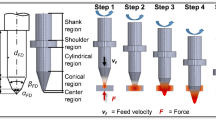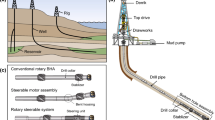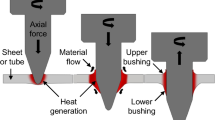Abstract
Directional drilling is a popular technique for oil well drilling. Accurate prediction of the directional performance is critical in order to achieve the desired well profile. Simplified geometry methods are, to date, the industry standard for predicting directional performance. A comprehensive, high-fidelity method for the simulation of directional drilling is presented here. It consists of a detailed discretization of the actual geometry and a rigorous application of two modeling techniques: the finite element and the finite segment methods. By doing so, the dynamic problem is addressed from two different yet complementary perspectives: structural mechanics and rigid-body motion. Collision detection and contact dynamics algorithms are also presented. Results show that both methods agree in terms of the dynamic response, and that the build rate estimations are consistent with available experimental data. Owing to the framework efficiency and physics-based nature, the presented tools are very well-suited for design engineering and real-time simulation.


















Similar content being viewed by others
References
Bak MK, Hansen MR (2013) Analysis of offshore knuckle boom crane—Part one: modeling and parameter identification. Model Identif Control 34(4):157–174
Bathe K (1975) An assessment of current finite element analysis of nonlinear problems in solid mechanics. In: Numerical solution of partial differential equations—III. Univ. Maryland
Bathe K (1996) Finite element procedures. Prentice Hall, Englewood Cliffs
Bathe K, Bolourchi S (1979) Large displacement analysis of three-dimensional beam structures. Int J Numer Methods Eng 14:961–986
Bathe K, Ramm E, Wilson E (1975) Finite element formulations for large deformation dynamic analysis. Int J Numer Methods Eng 9:353–386
Campos L, Oden J, Kikuchi N (1982) A numerical analysis of a class of contact problems with friction in elastostatics. Comput Methods Appl Mech Eng 34(1–3):821–845
Connelly J, Huston R (1994) The dynamics of flexible multibody systems: a finite segment approach—I. Theoretical aspects. Comput Struct 50(2):255–258
Connelly J, Huston R (1994) The dynamics of flexible multibody systems: A finite segment approach—II. Example problems. Comput Struct 50(2):259–262
García de Jalón J, Bayo E (1994) Kinematic and dynamic simulation of multibody systems. The real-time challenge. Springer, New York
Goldsmith W (1960) Impact: the theory and physical behaviour of colliding solids. Edward Arnold, London
Guerra F, Browning R (1983) Comparison of two slideline methods using ADINA. Comput Struct 17(5–6):819–834
Gurbuz C, Neto AG, Pimenta PM (2015) Offshore drilling simulation using a beam to surface contact formulation. In: International conference on computational contact mechanics
Hamper MB, Recuero AM, Escalona JL, Shabana AA (2012) Use of finite element and finite segment methods in modeling rail flexibility: a comparative study. J Comput Nonlinear Dyn 7(4):041,007
Hamper MB, Zaazaa KE, Shabana AA (2012) Modeling railroad track structures using the finite segment method. Acta Mech 223(8):1707–1721
He B, Rui X, Wang G (2007) Riccati discrete time transfer matrix method for elastic beam undergoing large overall motion. Multibody Syst Dyn 18(4):579–598
Hunt KH, Crossley FE (1975) Coefficient of restitution interpreted as damping in vibroimpact. ASME J Appl Mech 42(2):440–445
Huston R, Wang Y (1994) Flexibility effects in multibody systems. In: Pereira MFOS, Ambrósio JAC (eds) Computer-aided analysis of rigid and flexible mechanical systems. Springer, Berlin, pp 351–376
Kikuchi N, Song Y (1981) Penalty fnite element approximations of a class of unilateral problems in linear elasticity. Quart Appl Mech 39(1):1–21
Lankarani HM, Nikravesh PE (1990) A contact force model with hysteresis damping for impact analysis of multibody systems. ASME J Mech Des 112(3):369–376
Li Z, Ma X, Huang W, Liu X et al (1996) A 3D analysis of a bottomhole assembly under large deflection. SPE Drill Complet 11(02):104–110
Marchand N, Kalantari M et al (2013) A new approach for build rate estimation of downhole motors. In: SPE annual technical conference and exhibition. Society of Petroleum Engineers
Marhefka D, Orin D (1999) A compliant contact model with nonlinear damping for simulation of robotic systems. IEEE Trans Syst Man Cybern Part A 29(6):566–572
McSpadden AR, Coker OD, Ruan GC et al (2011) Advanced casing design with finite-element model of effective dogleg severity, radial displacements and bending loads. In: SPE production and operations symposium. Society of Petroleum Engineers
Menand S, Sellami H, Tijani M, Stab O, Dupuis DC, Simon C et al (2006) Advancements in 3D drillstring mechanics: from the bit to the topdrive. In: IADC/SPE drilling conference. Society of Petroleum Engineers
Muthukumar S, DesRoches R (2006) A Hertz contact model with non-linear damping for pounding simulation. Earthq Eng Struct Dyn 35(7):811–828
Neto AG, Martins CA, Pimenta PM (2014) Static analysis of offshore risers with a geometrically-exact 3D beam model subjected to unilateral contact. Comput Mech 53(1):125–145
Neto AG, Pimenta PM, Wriggers P (2015) Self-contact modeling on beams experiencing loop formation. Comput Mech 55(1):193–208
Parisch H, Lubbing C (1997) Formulation of arbitrary shaped surface elements for 3D large deformations contact with friction. Int J Numer Methods Eng 40(18):3359–3383
Przemieniecki J (1968) Theory of matrix structural analysis. Dover Publications INC, New York
Shen RW, Lei G (2012) Introduction to the explicit finite element method for nonlinear transient dynamics. Wiley, New York
Studer R, Menand S, Bourgoin S et al (2015) Advanced drilling engineering methodology proves robust in preventing mechanical lock-up while deploying sand-control completions through complex 3D drains. In: SPE/IADC drilling conference and exhibition. Society of Petroleum Engineers
Sugiyama H, Kobayashi N, Komaki Y (2005) Modeling and experimental methods for dynamic analysis of the spaghetti problem. J Vib Acoust 127(1):44–51
Tikhonov V, Valiullin K, Nurgaliev A, Ring L, Gandikota R, Chaguine P, Cheatham C et al (2013) Dynamic model for stiff string torque and drag. In: SPE/IADC drilling conference. Society of Petroleum Engineers
Tuzcu I, Nguyen N (2014) Flutter of maneuvering aircraft. J Aerosp Eng 28(4):04014094
Valembois R, Fisette P, Samin JC (1997) Comparison of various techniques for modelling flexible beams in multibody dynamics. Nonlinear Dyn 12(4):367–397
Wang Y, Huston R (1994) A lumped parameter method in the nonlinear analysis of flexible multibody systems. Comput Struct 50(3):421–432
Wilkins ML (1964) Calculation of elastic-plastic flow. In: Alder B et al (eds) Methods of computational physics, vol 3. Academic Press, New York
Yang YB, Lin SP, Chen CS (2007) Rigid body considerations for geometric nonlinear analysis of structures based on the updated Lagrangian formulation. In: Yao ZH, Yuan MW (eds) Computational methods in engineering & science. Springer, Berlin, pp 113–128
Zhong H (1993) Finite element procedures for contact-impact problems. Oxford Science Publications, Oxford
Acknowledgments
The authors acknowledge the support from the Collaborative Research and Development Grants of the Natural Sciences and Engineering Research Council of Canada (NSERC), in partnership with National Oilwell Varco—Canada.
Author information
Authors and Affiliations
Corresponding author
Rights and permissions
About this article
Cite this article
Arbatani, S., Callejo, A., Kövecses, J. et al. An approach to directional drilling simulation: finite element and finite segment methods with contact. Comput Mech 57, 1001–1015 (2016). https://doi.org/10.1007/s00466-016-1274-2
Received:
Accepted:
Published:
Issue Date:
DOI: https://doi.org/10.1007/s00466-016-1274-2




